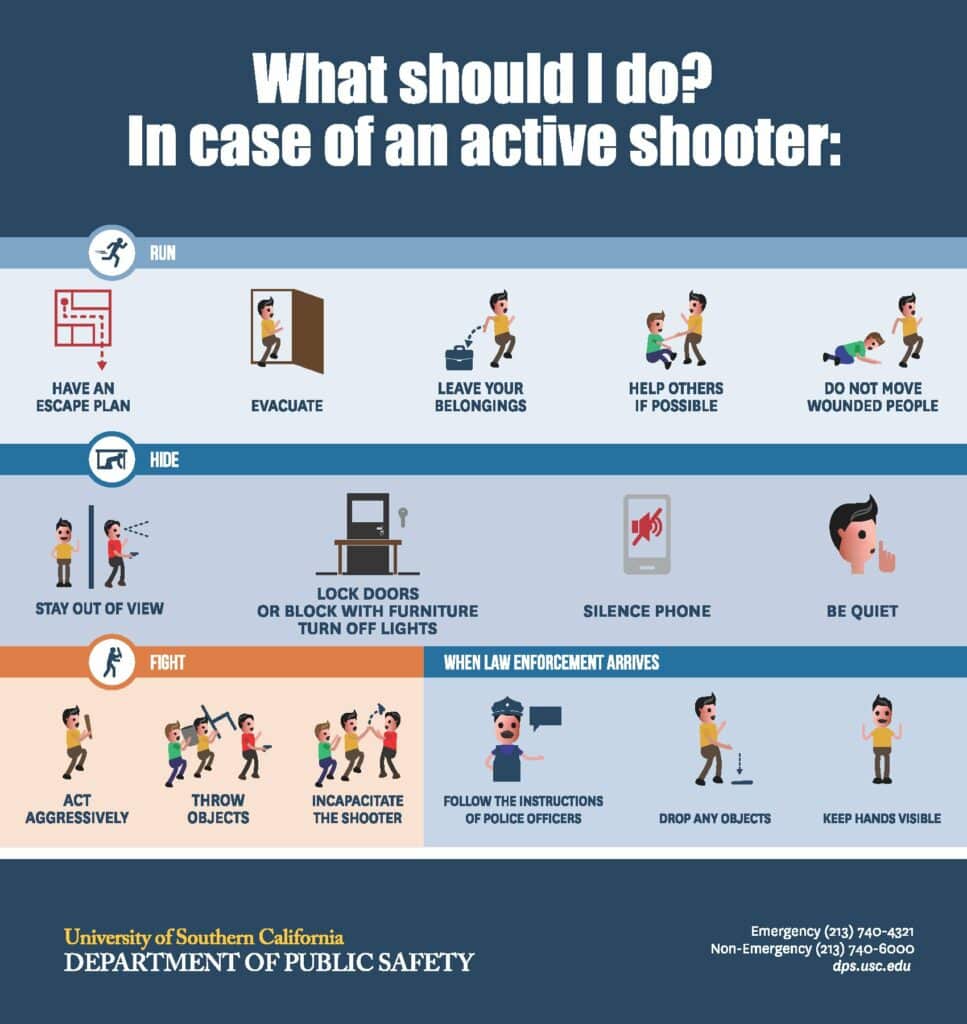The world we live in today is unpredictable, and the threat of active shooter incidents remains a constant concern. Having a well-prepared and effective active shooter response plan is critical in ensuring the safety and well-being of everyone involved.
This article will dive into the essential aspects of crafting an active shooter response plan, including understanding the nature of such events, developing a comprehensive response strategy, implementing prevention measures, and training employees.
Let’s explore the various components of an effective plan that can save lives and minimize the impact of these tragic situations.
On This Page:
Understanding Active Shooter Incidents

Active shooter incidents are terrifying and chaotic events that can unfold rapidly, leaving little time for those involved to respond. In order to effectively prepare for and respond to such incidents, it is vital to first understand the nature of active shooter situations and their common characteristics.
These incidents often involve an individual or individuals using firearms to indiscriminately attack people in a confined and populated area. The unpredictability and speed at which these events occur make it crucial for organizations and individuals to be well-prepared and equipped to handle such emergencies.
Definition of an Active Shooter
An active shooter is an individual actively engaging in the act of killing or attempting to kill people in a confined and populated area. Active shooter situations often unfold rapidly, with little or no warning, and can result in significant casualties. In most cases, the primary objective of the shooter is to inflict harm and cause panic, making it critical for those involved to be knowledgeable about the appropriate response strategies and tactics to minimize the risk to themselves and others.
Common Characteristics of Active Shooter Events
Active shooter events typically occur in public areas and are unpredictable, progressing rapidly, and causing considerable loss of life. They often involve shooters who are motivated by a variety of factors, such as personal grievances, mental health issues, or ideological beliefs.
To better prepare for and respond to such events, you should establish strategic escape routes and identify shelter-in-place locations within the workplace that can protect employees during an active shooter situation. Ensuring that all individuals at the workplace are familiar with these measures is critical in the event of an active shooter incident.
Developing a Comprehensive Response Plan

A comprehensive response plan is essential for mitigating the impact of an active shooter event and ensuring the safety of all individuals involved. The plan should be designed to precisely define what employees and the organization should execute during all stages of an active shooter situation.
The key elements of a comprehensive response plan include identifying roles and responsibilities, establishing communication channels, and integrating with local law enforcement and emergency services.
Identifying Roles and Responsibilities
An effective active shooter response plan should designate a leader to coordinate emergency operations plans and assess the organization’s capacity to respond to workplace violence. This leader should work closely with other personnel involved in the response plan, such as security personnel, medical staff, and communication teams, to ensure a coordinated effort during an active shooter incident.
Additionally, provide training and education to all staff members on active shooter response protocols, including recognizing warning signs, reporting suspicious activity, and knowing how to react during an incident.
Establishing Communication Channels
A robust communication system is crucial during an active shooter event to ensure prompt and accurate information sharing among employees, visitors, and law enforcement agencies. An effective communication system should include pre-populated templates, up-to-date contact information, and support for multichannel, two-way mass communication, such as email, cell phone, text messaging, mobile apps, pagers, and radio communication channels.
This will allow for efficient coordination and dissemination of critical information during an active shooter situation, ultimately contributing to all individuals’ safety.
Integrating with Local Law Enforcement and Emergency Services
Collaborating with local law enforcement and emergency services is crucial to enhance response capabilities and ensure a coordinated effort during active shooter incidents.
This collaboration may involve:
- Sharing information about the organization’s response plan
- Conducting joint training exercises
- Developing protocols for communication and coordination during an active shooter event
Prevention Strategies

Implementing prevention strategies can significantly reduce the likelihood of active shooter events and improve overall safety within an organization. These strategies encompass recognizing warning signs, establishing reporting procedures, and strengthening site security.
Recognizing Warning Signs
Education plays a crucial role in preventing active shooter incidents. Employees should be trained to:
- Identify common indicators and patterns of behavior that may suggest an individual poses a threat
- Familiarize themselves with these warning signs
- Report any concerns
By doing so, organizations can detect potential threats and take appropriate action to mitigate the risk of an active shooter event.
Providing informational materials, such as those from the U.S. Department of Homeland Security (DHS), can further enhance employees’ ability to recognize potentially dangerous individuals.
Implementing Reporting Procedures
Establishing accessible reporting procedures is an essential component of active shooter planning. A centralized, confidential reporting system should be in place to allow employees to report their observations of warning signs securely and without fear of reprisal.
Maintaining the confidentiality of reports also ensures that employees feel safe in disclosing their observations and that their reports will be taken seriously and handled appropriately.
Strengthening Site Security
Improving site security is a critical aspect of active shooter prevention. Measures such as:
- Controlled access
- Security personnel
- Locks
- Identification of interior shelter spaces
Can all contribute to a safer environment. By restricting access to the premises and ensuring that all individuals on site are authorized to be there, organizations can significantly reduce the risk of an active shooter event.
Furthermore, clearly identified shelter spaces and secure areas can provide employees with a safe haven in an active shooter situation.
Training and Education

Active shooter response training and education give employees the knowledge and skills necessary to respond effectively to an active shooter situation.
This includes understanding the various types of active shooter training available, as well as the importance of conducting regular drills and exercises to reinforce learning and ensure employees are prepared to respond in the event of an active shooter incident.
Types of Active Shooter Training
There are several active shooter training options available to suit the needs of different organizations and individuals. These include:
- FBI training videos
- ALICE Training (a civilian active shooter response training program with a trauma-informed approach)
- Training provided by CISA (Cybersecurity and Infrastructure Security Agency)
- AVERT – Active Violence Emergency Response Training
- Active Shooter Response and Preparedness Course
- Mock active shooter exercises
- Active shooter drills
Conducting Drills and Exercises
Regular drills and exercises ensure that employees are familiar with response procedures and prepared for active shooter situations. These drills should encompass scenarios that simulate an active shooter situation, such as lockdown, evacuation, and active shooter drills.
Engaging in drills and exercises can help employees become acquainted with response protocols, increase their confidence in responding to an active shooter situation, and ensure their readiness for such an occurrence. Employees should undergo active shooter training at least twice a year to maintain their preparedness.
Responding to an Active Shooter Situation

In an active shooter situation, employees must respond effectively and quickly to minimize the potential harm and loss of life. This includes following the Run, Hide, Fight or Move! Escape or Attack strategies, which emphasize proactive, options-based responses to violent situations.
Additionally, cooperating with law enforcement officers, including police officers, during active shooter incidents is crucial, as they have the necessary training and expertise to respond to such events and can offer guidance and support to those affected. It is important to remain calm and follow instructions when law enforcement arrives on the scene.
Run, Hide, Fight
The Run, Hide, Fight strategy emphasizes the following actions during an active shooter incident.
- Evacuate the area if there is an accessible escape path.
- Hide in a secure location if escaping is not possible.
- Fight back as a last resort if the shooter poses an imminent danger.
This approach encourages the individual actively engaged to take decisive action rather than passively waiting for help.
By running, hiding, or fighting, individuals can increase their chances of survival and minimize the potential harm caused by the shooter.
MOVE! Escape or Attack
The Move! Escape or Attack strategy focuses on proactive options-based strategies for surviving violent situations, including escaping or attacking the shooter. This approach encourages individuals to assess their environment and make a decision based on the available information, emphasizing the importance of taking action rather than passively hiding or waiting for help.
Cooperating with Law Enforcement Officers

During an active shooter incident, it is paramount to cooperate with law enforcement officers who are trained to respond to such situations. When law enforcement arrives, remain calm, follow their instructions, and keep their hands visible at all times to avoid misunderstandings.
Providing critical information to first responders can help law enforcement officers effectively neutralize the threat and ensure the safety of all individuals involved. This information includes:
- The number of shooters
- Their physical description
- Their location
- The location of the victims
Post-Event Recovery
Following an active shooter incident, it is crucial to focus on post-event recovery efforts, as these can significantly impact the well-being of affected individuals and the overall resilience of the organization. Post-event recovery involves providing emotional and physical support to those affected, as well as restoring business continuity to ensure the organization can resume operations as quickly as possible.
Organizations should develop a comprehensive post-event recovery plan that outlines the steps to be taken.
Providing Emotional and Physical Support
Offering emotional and physical support to employees impacted by an active shooter event is essential in addressing their needs and promoting healing. This can include providing counseling services, extending financial assistance, and granting access to medical care for those injured during the incident.
Restoring Business Continuity

Developing a business continuity plan is crucial to ensure the organization can resume operations as quickly as possible following an active shooter incident. This plan should identify the necessary personnel and resources, evaluate the damage caused by the incident, and outline a strategy for resuming normal operations.
Wrapping It Up
Crafting an effective active shooter response plan is paramount in today’s unpredictable world. By understanding the nature of active shooter incidents, developing a comprehensive response plan, implementing prevention strategies, and providing training and education to employees, organizations can significantly enhance their preparedness for such events.
Focusing on post-event recovery efforts, including offering emotional and physical support to those affected and restoring business continuity, can further improve the organization’s resilience. By taking these proactive steps, organizations can help protect their employees and minimize the impact of active shooter incidents on their operations and communities.
Frequently Asked Questions
What is the OSHA emergency action plan for an active shooter?
In the event of an active shooter, it is advised to evacuate or hide if possible; if not, contact 911 and provide details of the location, shooter, and weapons. Remain calm and listen to directions from the dispatcher.
What should you do when an active shooter is in your vicinity?
In the event of an active shooter in your vicinity, call 911 when safe and find a secure place to hide out of view with protection from potential shots. Lock the doors for additional safety.
What is an ALICE drill?
ALICE drills are lockdown drills developed in response to an intruder or active shooter threat, designed to train educators and administrators on procedures such as ALERT, LOCKDOWN, INFORM, CONTACT, and EVACUATE. This is done to provide schools with the necessary protocols to ensure safety.
What are the key components of an effective active shooter response plan?
Effective active shooter response plans should include identifying roles and responsibilities, establishing communication channels, integrating with law enforcement and emergency services, implementing prevention strategies, and providing employee training and education.
These plans should be tailored to the organization’s specific needs and should be regularly reviewed and updated. Ensure that all employees are aware of the plan and understand their roles and responsibilities in the event of an active shooter situation.



